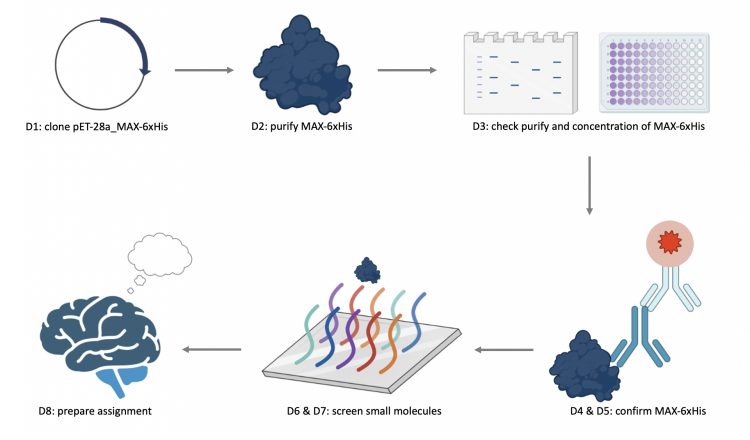20.109(S23):Module 1
Contents
Module 1: drug discovery
Small molecules, or ligands, are important research tools used to explore cellular processes and therapeutic targets. The use of high-throughput and unbiased strategies to identify small molecules that bind specific biomolecules, such as proteins, can provide insight on the structure or function of targets. Additionally, a small-molecule screen can identify new chemical probes for target proteins of interest.
The small-molecule microarray (SMM) is a high-throughput method that enables the detection of protein-ligand binding. Briefly, ligands are 'printed' onto a slide and incubated with purifed protein. Unbound protein is washed from the slide and bound protein is detected using a tag on the protein of interest. Because the location of every ligand on the slide is known, the detection of protein indicates that it is bound to the ligand at that location.
In this module, you will leverage the SMM technology to identify small molecules that putatively bind MAX (myc-associated factor X), our protein target. The MAX protein contains the basic helix-loop-helix and leucine zipper motifs and functions as a transcription factor in humans. In this role, it forms homodimers and heterodimers with other transcriptional factors. Notably MAX dimerizes with Myc, an oncogenic transcription factor. Because this dimerization is required for Myc to act as a transcription factor, inhibitors of this process are clinically relevant and may lead to the development of a drug therapy to treat cancer.
Research goal: Identify small molecules that putatively bind to MAX using SMM technology.
Lab links: day by day
M1D1: Complete in-silico cloning of protein expression plasmid
M1D2: Perform protein purification protocol
M1D3: Assess purity and concentration of purified protein
M1D4: Confirm purified protein using Western blot
M1D5: Image Western blot of purified protein
M1D6: Prepare and scan small molecule microarray (SMM) slides
M1D7: Analyze SMM data to identify putative small molecule binders
M1D8: Organize Data summary figures and results
Major assignments
References
- A method for the covalent capture and screening of diverse small molecules in a microarray format. Nature Protocols. 1:2344-2352.
- Recent discoveries and applications involving small-molecule microarrays. Chemical Biology. 18:21-28.

